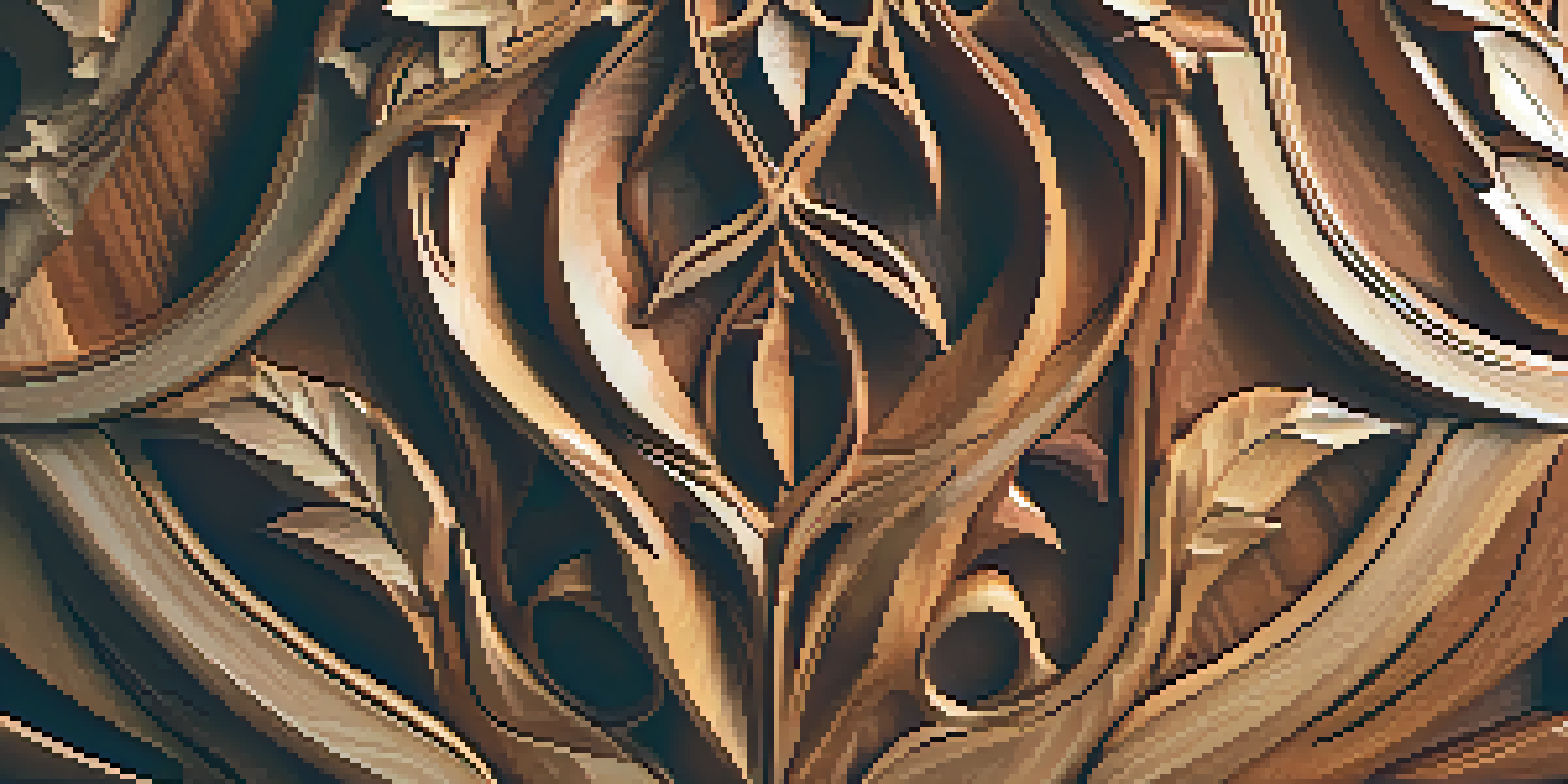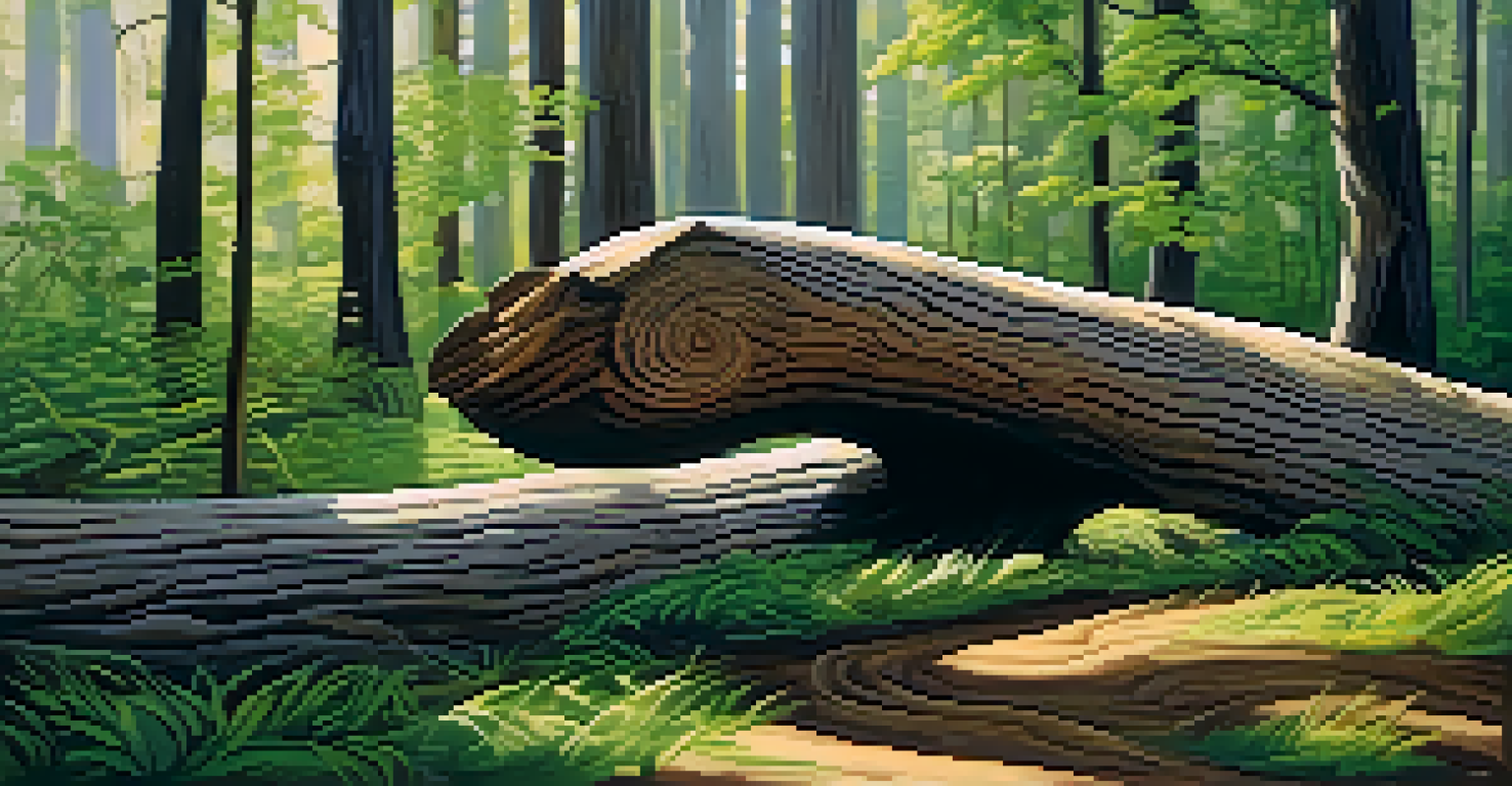The Art of Wood Carving: Nature's Influence on Design Choices

Understanding Wood Carving: A Natural Craft
Wood carving is more than just a craft; it’s an art form deeply rooted in nature. Each piece of wood carries its own unique character, influenced by its growth environment. From the gnarled knots of an old oak to the smooth grains of pine, wood tells a story of its journey through the natural world.
Wood carving is not just a craft; it's a reflection of nature's beauty and a dialogue between the artist and the material.
As artisans, wood carvers draw inspiration from these natural features, allowing the material to guide their designs. This relationship between the artist and the wood creates pieces that resonate with authenticity. It’s a dialogue where the wood speaks, and the carver listens, shaping their vision around the material's inherent beauty.
Ultimately, understanding the nuances of wood is essential for any aspiring carver. By appreciating the natural imperfections and variations, one can create art that honors the essence of the wood itself.
Nature's Patterns: Inspiration in Every Grain
The patterns found in wood grain serve as a direct link to nature’s artistry. These distinctive swirls and lines can inspire a variety of designs, from intricate sculptures to simple furniture. For instance, a piece of driftwood may evoke thoughts of ocean waves, leading to a design that mimics this fluidity.

Moreover, these natural patterns can also inform the carving techniques used. A woodworker may choose to highlight the grain by employing specific carving methods that enhance its natural beauty. This not only brings the wood to life but also creates a visual narrative that connects the piece to its origins.
Nature Inspires Wood Carving Art
Wood carvers draw inspiration from the natural characteristics of wood, allowing its unique patterns and imperfections to guide their artistic expression.
Incorporating these natural patterns into designs allows carvers to celebrate the uniqueness of each wood type. This practice not only respects the material but also invites viewers to appreciate the artistry found in nature.
Choosing the Right Wood: A Sustainable Approach
Selecting the right type of wood is crucial for any carving project, and sustainability plays a key role in this decision. Many carvers prefer locally sourced or reclaimed wood, which not only reduces environmental impact but also tells a story of its own. This conscious choice reflects a growing trend in the craft community towards more eco-friendly practices.
The best artist has no conception that a marble block does not contain within it the form of a statue; it must be revealed by the hands of the sculptor.
Different woods offer different characteristics, influencing both the carving process and the final appearance of the piece. For example, softer woods like basswood are easier to carve and ideal for beginners, while hardwoods like walnut provide durability and a rich aesthetic. Understanding these properties helps carvers make informed decisions that enhance their creative expressions.
Ultimately, selecting sustainable materials fosters a deeper connection between the artist and the environment. This mindful approach encourages a crafting process that values nature's resources while inspiring designs that resonate with eco-conscious consumers.
Nature's Colors: The Palette of Wood Carving
The colors found in wood are a natural manifestation of the environment where the tree thrived. From the warm hues of cherry to the cool tones of ash, these colors can significantly influence design choices. Carvers often select wood not just for its workability, but for its vibrant colors that can enhance the overall aesthetic of their creations.
In addition, many artisans choose to enhance these natural colors through various finishing techniques. Oils, stains, and lacquers can deepen or alter the wood’s appearance, bringing out its unique character. This process allows carvers to manipulate the natural palette, creating pieces that are both visually stunning and reflective of their surroundings.
Sustainable Wood Selection Matters
Choosing locally sourced or reclaimed wood not only supports eco-friendly practices but also enhances the artistry by telling a story of the material's journey.
Color in wood carving is not merely an afterthought; it is an integral part of the design process. By considering the wood's natural hues, artists can create harmonious pieces that resonate with the beauty of nature.
The Role of Nature in Design Inspiration
Nature serves as a boundless source of inspiration for wood carvers, offering shapes, forms, and concepts that can be translated into art. From the delicate curves of a leaf to the robust structure of a tree trunk, these elements can inspire everything from abstract sculptures to realistic wildlife carvings. By observing the world around them, artists can capture the essence of nature in their work.
Many wood carvers find that spending time outdoors enhances their creativity. A walk in the woods may spark an idea for a new project or provide insight into the textures and patterns that can be replicated in wood. This connection to the natural world is essential for fostering an innovative spirit in the craft.
Ultimately, nature’s influence on design choices enriches the creative process. It encourages wood carvers to explore and experiment, leading to unique and meaningful pieces that reflect their appreciation for the environment.
Techniques for Capturing Nature in Wood Carving
To effectively capture the beauty of nature in wood carving, various techniques can be employed. Relief carving, for example, allows artists to create designs that pop out from the surface, mimicking the three-dimensional qualities of natural forms. This technique can beautifully represent landscapes, animals, or floral motifs, bringing the essence of nature into a tangible form.
Another popular method is chip carving, which involves removing small chips of wood to create intricate patterns. This technique is often used to reflect the geometric shapes found in nature, such as the symmetry of leaves or the angularity of mountains. By mastering these techniques, wood carvers can enhance their ability to depict natural elements in their work.
Techniques Capture Nature's Beauty
Various carving techniques, such as relief and chip carving, enable artisans to replicate the beauty of natural forms in their woodworks.
With practice and patience, these techniques can bring the beauty of the natural world to life in wood. Each carved piece becomes a celebration of nature's artistry, offering viewers a glimpse of the inspiration that fuels the craft.
The Future of Wood Carving: Nature's Enduring Influence
As the world evolves, so does the art of wood carving, yet nature remains a timeless influence. Contemporary carvers are increasingly blending traditional techniques with modern designs, creating pieces that reflect both innovation and respect for the natural world. This fusion not only keeps the craft alive but also introduces new audiences to the beauty of wood art.
Sustainability continues to play a crucial role in the future of wood carving. With a growing awareness of environmental issues, many artisans are committed to using responsibly sourced materials and eco-friendly practices. This commitment ensures that the art form can flourish while preserving the natural resources that inspire it.

Ultimately, the relationship between wood carvers and nature will always be intertwined. As long as there are trees, there will be wood, and with it, the potential to create art that honors the beauty of the natural world.